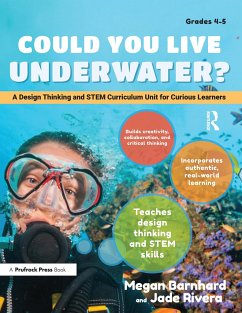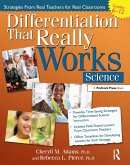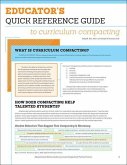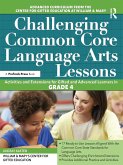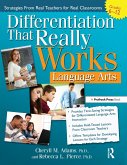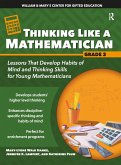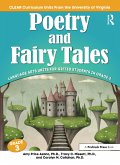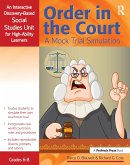Megan Barnhard, Jade Rivera
Could You Live Underwater?
A Design Thinking and Stem Curriculum Unit for Curious Learners (Grades 4-5)
Megan Barnhard, Jade Rivera
Could You Live Underwater?
A Design Thinking and Stem Curriculum Unit for Curious Learners (Grades 4-5)
- Broschiertes Buch
- Merkliste
- Auf die Merkliste
- Bewerten Bewerten
- Teilen
- Produkt teilen
- Produkterinnerung
- Produkterinnerung
In this engaging design thinking adventure, students utilize STEM skills and creative thinking to research, design, and build prototypes of the underwater house of the future!
Andere Kunden interessierten sich auch für
![Differentiation That Really Works Differentiation That Really Works]() Cheryll M AdamsDifferentiation That Really Works22,99 €
Cheryll M AdamsDifferentiation That Really Works22,99 €![Educator's Quick Reference Guide to Curriculum Compacting Educator's Quick Reference Guide to Curriculum Compacting]() Sally M ReisEducator's Quick Reference Guide to Curriculum Compacting16,99 €
Sally M ReisEducator's Quick Reference Guide to Curriculum Compacting16,99 €![Challenging Common Core Language Arts Lessons Challenging Common Core Language Arts Lessons]() Clg Of William And Mary / Ctr Gift EdChallenging Common Core Language Arts Lessons35,99 €
Clg Of William And Mary / Ctr Gift EdChallenging Common Core Language Arts Lessons35,99 €![Differentiation That Really Works Differentiation That Really Works]() Cheryll M AdamsDifferentiation That Really Works22,99 €
Cheryll M AdamsDifferentiation That Really Works22,99 €![Thinking Like a Mathematician Thinking Like a Mathematician]() Mary-Lyons Walk HanksThinking Like a Mathematician35,99 €
Mary-Lyons Walk HanksThinking Like a Mathematician35,99 €![Poetry and Fairy Tales Poetry and Fairy Tales]() Amy Price AzanoPoetry and Fairy Tales49,99 €
Amy Price AzanoPoetry and Fairy Tales49,99 €![Order in the Court Order in the Court]() Richard CoteOrder in the Court28,99 €
Richard CoteOrder in the Court28,99 €-
In this engaging design thinking adventure, students utilize STEM skills and creative thinking to research, design, and build prototypes of the underwater house of the future!
Hinweis: Dieser Artikel kann nur an eine deutsche Lieferadresse ausgeliefert werden.
Hinweis: Dieser Artikel kann nur an eine deutsche Lieferadresse ausgeliefert werden.
Produktdetails
- Produktdetails
- Verlag: Taylor & Francis
- Seitenzahl: 156
- Altersempfehlung: 9 bis 13 Jahre
- Erscheinungstermin: 1. April 2018
- Englisch
- Abmessung: 277mm x 213mm x 10mm
- Gewicht: 386g
- ISBN-13: 9781618217509
- ISBN-10: 161821750X
- Artikelnr.: 49360205
- Herstellerkennzeichnung
- Libri GmbH
- Europaallee 1
- 36244 Bad Hersfeld
- gpsr@libri.de
- Verlag: Taylor & Francis
- Seitenzahl: 156
- Altersempfehlung: 9 bis 13 Jahre
- Erscheinungstermin: 1. April 2018
- Englisch
- Abmessung: 277mm x 213mm x 10mm
- Gewicht: 386g
- ISBN-13: 9781618217509
- ISBN-10: 161821750X
- Artikelnr.: 49360205
- Herstellerkennzeichnung
- Libri GmbH
- Europaallee 1
- 36244 Bad Hersfeld
- gpsr@libri.de
Megan Barnhard is an author, writing coach, and curriculum creator committed to helping writers tame the writing process and enjoy self-expression. Jade Rivera is a micro-school builder, author, and STEM educator dedicated to helping gifted learners thrive.
Introduction How to Use This Book Getting Started Module: What Is Design
Thinking Mini-Lesson 0.1: What Does Design Thinking Have to Do With Me?
Mini-Lesson 0.2: Introduction to Blogging Concluding Activities Handouts
Module 1: Empathizing and Setting Up the Problem Mini-Lesson 1.1:
Introducing the Problem Mini-Lesson 1.2: What Should I Highlight?: A Guide
to Active Reading and Annotating Mini-Lesson 1.3: How Would That Feel?: A
Guide to Building Empathy Mini-Lesson 1.4: Writing a Response to a Problem
and Creating a Problem Statement Mini-Lesson 1.5: What Should I Say?: A
Guide to Effective Feedback Concluding Activities Handouts Module 2:
Research and Ideation Mini-Lesson 2.1: Open-Ended Questions for Research
Mini-Lesson 2.2: Where Can I Find Accurate Information?: A Guide to
Choosing Reliable Resources Mini-Lesson 2.3: How Do I Get Answers on the
Web?: A Guide to Effective Online Research Mini-Lesson 2.4: What's the Most
Important Idea?: A Guide to Paraphrasing and Taking Notes Concluding
Activities Handouts Module 3: Guided Experimentation Mini-Lesson 3.1: What
Will Happen?: A Guide to Forming a Hypothesis Mini-Lesson 3.2: What
Happened?: A Guide to Quantitative and Qualitative Observation Mini-Lesson
3.3: Guided Experimentation Concluding Activities Handouts Module 4:
Designing and Building Prototypes Mini-Lesson 4.1: Challenges, Needs,
Advantages, and Opportunities of Designing Underwater Mini-Lesson 4.2: What
Will It Do in Saltwater? Mini-Lesson 4.3: Guidelines for Designing
Concluding Activities Handouts Module 5: Testing Prototypes Mini-Lesson
5.1: Evaluation Criteria Mini-Lesson 5.2: A Guide to Constructive
Evaluation Concluding Activities Handouts Module 6: Sharing Findings
Mini-Lesson 6.1: Writing a Response Mini-Lesson 6.2: Creating a Table of
Contents Concluding Activities Handouts Appendix A: Design Thinking
Resources Appendix B: Resources for Creating a Classroom Blog Appendix C:
Rubrics About the Authors Common Core State Standards Alignment Next
Generation Science Standards Alignment
Thinking Mini-Lesson 0.1: What Does Design Thinking Have to Do With Me?
Mini-Lesson 0.2: Introduction to Blogging Concluding Activities Handouts
Module 1: Empathizing and Setting Up the Problem Mini-Lesson 1.1:
Introducing the Problem Mini-Lesson 1.2: What Should I Highlight?: A Guide
to Active Reading and Annotating Mini-Lesson 1.3: How Would That Feel?: A
Guide to Building Empathy Mini-Lesson 1.4: Writing a Response to a Problem
and Creating a Problem Statement Mini-Lesson 1.5: What Should I Say?: A
Guide to Effective Feedback Concluding Activities Handouts Module 2:
Research and Ideation Mini-Lesson 2.1: Open-Ended Questions for Research
Mini-Lesson 2.2: Where Can I Find Accurate Information?: A Guide to
Choosing Reliable Resources Mini-Lesson 2.3: How Do I Get Answers on the
Web?: A Guide to Effective Online Research Mini-Lesson 2.4: What's the Most
Important Idea?: A Guide to Paraphrasing and Taking Notes Concluding
Activities Handouts Module 3: Guided Experimentation Mini-Lesson 3.1: What
Will Happen?: A Guide to Forming a Hypothesis Mini-Lesson 3.2: What
Happened?: A Guide to Quantitative and Qualitative Observation Mini-Lesson
3.3: Guided Experimentation Concluding Activities Handouts Module 4:
Designing and Building Prototypes Mini-Lesson 4.1: Challenges, Needs,
Advantages, and Opportunities of Designing Underwater Mini-Lesson 4.2: What
Will It Do in Saltwater? Mini-Lesson 4.3: Guidelines for Designing
Concluding Activities Handouts Module 5: Testing Prototypes Mini-Lesson
5.1: Evaluation Criteria Mini-Lesson 5.2: A Guide to Constructive
Evaluation Concluding Activities Handouts Module 6: Sharing Findings
Mini-Lesson 6.1: Writing a Response Mini-Lesson 6.2: Creating a Table of
Contents Concluding Activities Handouts Appendix A: Design Thinking
Resources Appendix B: Resources for Creating a Classroom Blog Appendix C:
Rubrics About the Authors Common Core State Standards Alignment Next
Generation Science Standards Alignment
Introduction How to Use This Book Getting Started Module: What Is Design
Thinking Mini-Lesson 0.1: What Does Design Thinking Have to Do With Me?
Mini-Lesson 0.2: Introduction to Blogging Concluding Activities Handouts
Module 1: Empathizing and Setting Up the Problem Mini-Lesson 1.1:
Introducing the Problem Mini-Lesson 1.2: What Should I Highlight?: A Guide
to Active Reading and Annotating Mini-Lesson 1.3: How Would That Feel?: A
Guide to Building Empathy Mini-Lesson 1.4: Writing a Response to a Problem
and Creating a Problem Statement Mini-Lesson 1.5: What Should I Say?: A
Guide to Effective Feedback Concluding Activities Handouts Module 2:
Research and Ideation Mini-Lesson 2.1: Open-Ended Questions for Research
Mini-Lesson 2.2: Where Can I Find Accurate Information?: A Guide to
Choosing Reliable Resources Mini-Lesson 2.3: How Do I Get Answers on the
Web?: A Guide to Effective Online Research Mini-Lesson 2.4: What's the Most
Important Idea?: A Guide to Paraphrasing and Taking Notes Concluding
Activities Handouts Module 3: Guided Experimentation Mini-Lesson 3.1: What
Will Happen?: A Guide to Forming a Hypothesis Mini-Lesson 3.2: What
Happened?: A Guide to Quantitative and Qualitative Observation Mini-Lesson
3.3: Guided Experimentation Concluding Activities Handouts Module 4:
Designing and Building Prototypes Mini-Lesson 4.1: Challenges, Needs,
Advantages, and Opportunities of Designing Underwater Mini-Lesson 4.2: What
Will It Do in Saltwater? Mini-Lesson 4.3: Guidelines for Designing
Concluding Activities Handouts Module 5: Testing Prototypes Mini-Lesson
5.1: Evaluation Criteria Mini-Lesson 5.2: A Guide to Constructive
Evaluation Concluding Activities Handouts Module 6: Sharing Findings
Mini-Lesson 6.1: Writing a Response Mini-Lesson 6.2: Creating a Table of
Contents Concluding Activities Handouts Appendix A: Design Thinking
Resources Appendix B: Resources for Creating a Classroom Blog Appendix C:
Rubrics About the Authors Common Core State Standards Alignment Next
Generation Science Standards Alignment
Thinking Mini-Lesson 0.1: What Does Design Thinking Have to Do With Me?
Mini-Lesson 0.2: Introduction to Blogging Concluding Activities Handouts
Module 1: Empathizing and Setting Up the Problem Mini-Lesson 1.1:
Introducing the Problem Mini-Lesson 1.2: What Should I Highlight?: A Guide
to Active Reading and Annotating Mini-Lesson 1.3: How Would That Feel?: A
Guide to Building Empathy Mini-Lesson 1.4: Writing a Response to a Problem
and Creating a Problem Statement Mini-Lesson 1.5: What Should I Say?: A
Guide to Effective Feedback Concluding Activities Handouts Module 2:
Research and Ideation Mini-Lesson 2.1: Open-Ended Questions for Research
Mini-Lesson 2.2: Where Can I Find Accurate Information?: A Guide to
Choosing Reliable Resources Mini-Lesson 2.3: How Do I Get Answers on the
Web?: A Guide to Effective Online Research Mini-Lesson 2.4: What's the Most
Important Idea?: A Guide to Paraphrasing and Taking Notes Concluding
Activities Handouts Module 3: Guided Experimentation Mini-Lesson 3.1: What
Will Happen?: A Guide to Forming a Hypothesis Mini-Lesson 3.2: What
Happened?: A Guide to Quantitative and Qualitative Observation Mini-Lesson
3.3: Guided Experimentation Concluding Activities Handouts Module 4:
Designing and Building Prototypes Mini-Lesson 4.1: Challenges, Needs,
Advantages, and Opportunities of Designing Underwater Mini-Lesson 4.2: What
Will It Do in Saltwater? Mini-Lesson 4.3: Guidelines for Designing
Concluding Activities Handouts Module 5: Testing Prototypes Mini-Lesson
5.1: Evaluation Criteria Mini-Lesson 5.2: A Guide to Constructive
Evaluation Concluding Activities Handouts Module 6: Sharing Findings
Mini-Lesson 6.1: Writing a Response Mini-Lesson 6.2: Creating a Table of
Contents Concluding Activities Handouts Appendix A: Design Thinking
Resources Appendix B: Resources for Creating a Classroom Blog Appendix C:
Rubrics About the Authors Common Core State Standards Alignment Next
Generation Science Standards Alignment

